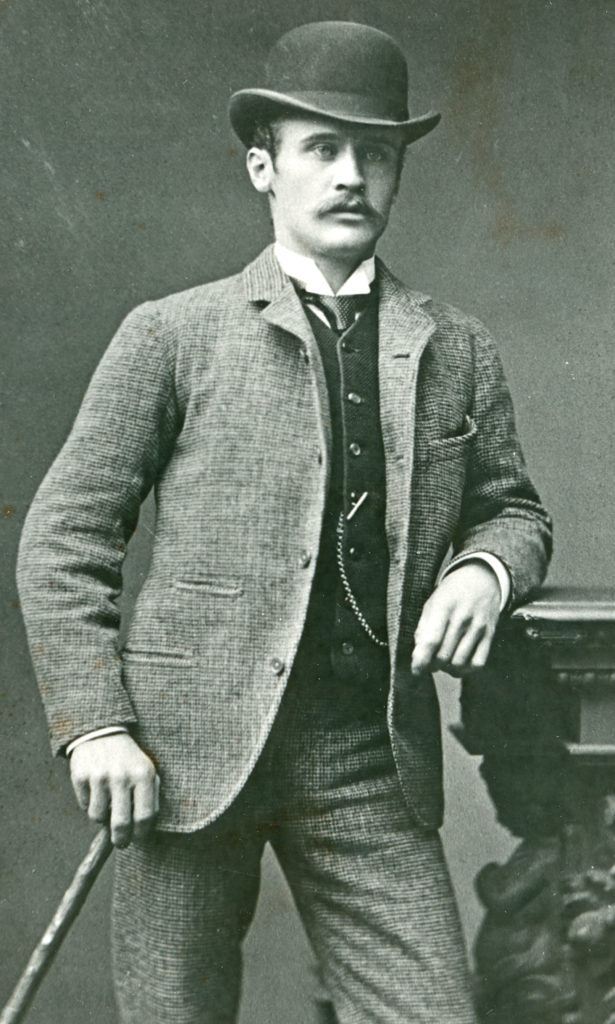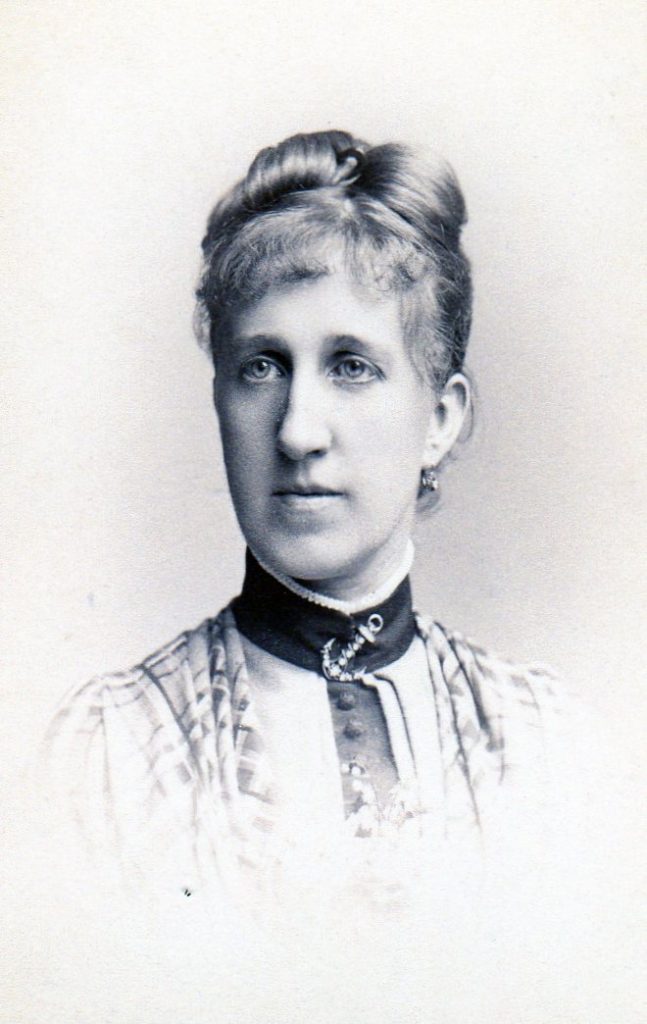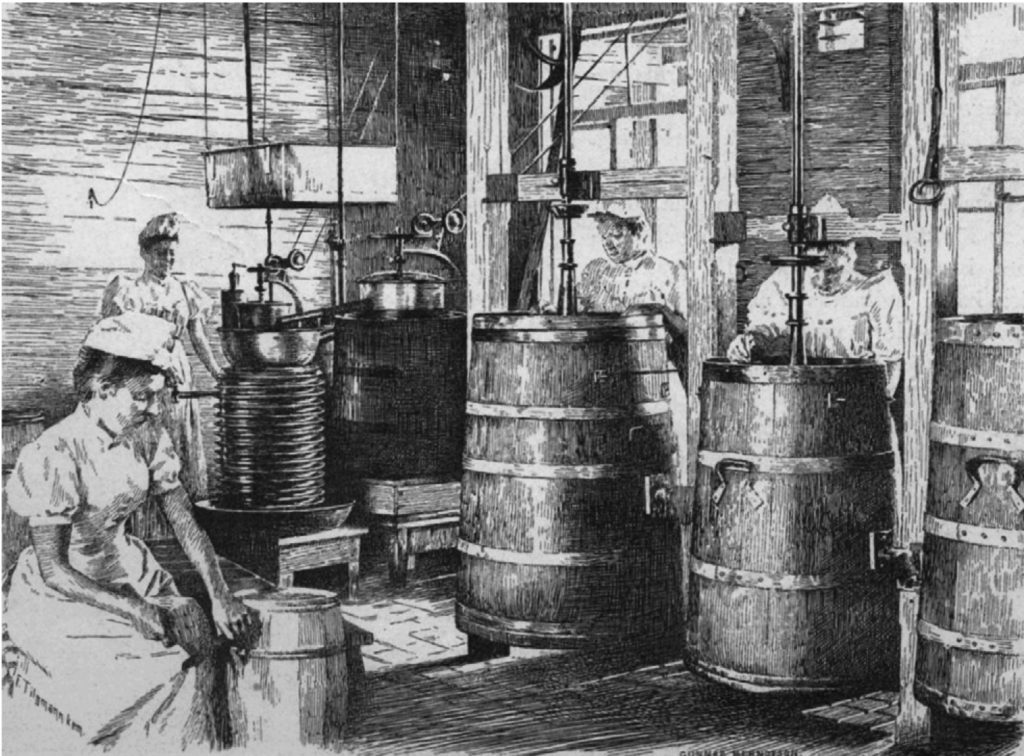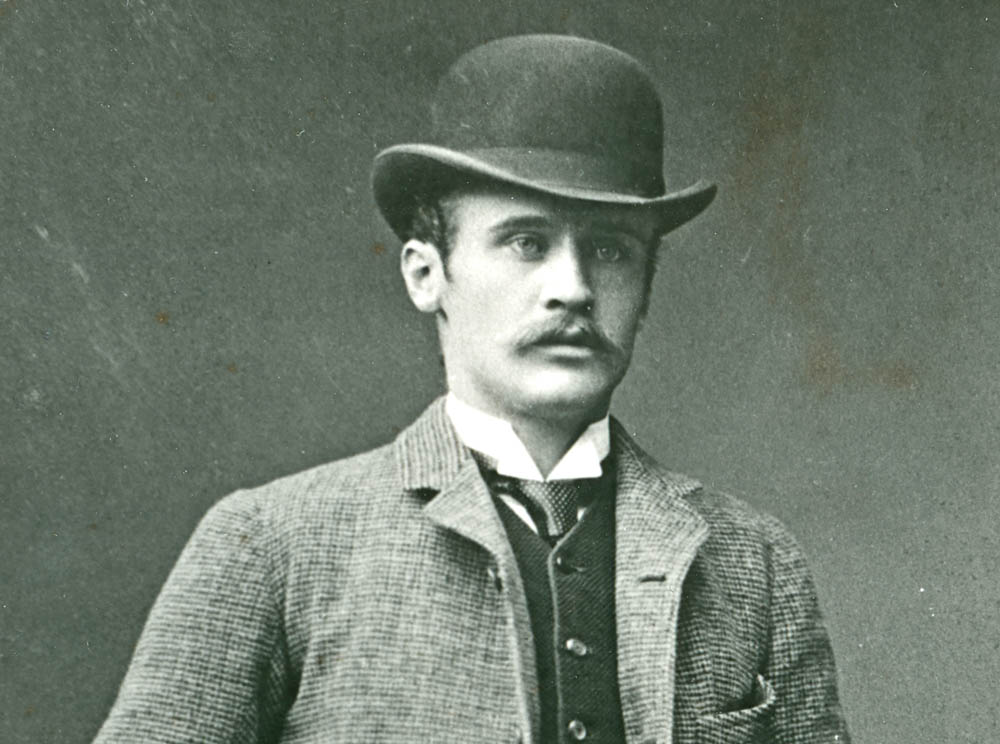
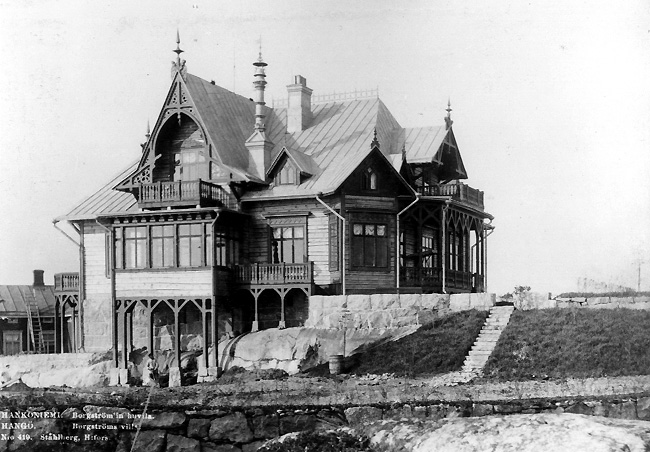
Arthur Hjalmar Borgström was born in Helsinki in 1859, his mother was English and his father Finnish. The boy grew up a successful businessman and a lover of the arts. He moved to Hanko in 1888 and founded one of the city's first Finnish butter export shops.
Länsisataman keskellä sijaitsi ennen korkea kallio. Sen laella seisoi voikeisari Borgströmin satumaisen kaunis huvila, jonka ikkunoista avautui näkymä silokallioiden yli merelle, taivaanrantaan asti.
Arthur Hjalmar Borgström syntyi Helsingissä vuonna 1859, äiti oli englantilainen, isä suomalainen. Pojasta varttui menestyvä liikemies ja taiteiden ystävä. Hankoon hän muutti vuonna 1888 ja perusti yhden kaupungin ensimmäisistä suomalaisista voinvientiliikkeistä. Puun ja paperin ohella voi oli pitkään Suomen tärkein vientituote. Suuri osa länteen viedystä voista kulki Hangon sataman kautta, enimmäkseen Tanskaan ja Englantiin.
Voikeisariksi tituleerattu Borgström kehitti alaa monella tapaa. Hän oli mukana perustamassa Hangon meijeriä, kokeili erilaisia tekniikoita ja onnistui luomaan kermanjäähdytysmenetelmän. Kun vienti Hansakaupunkeihin tyrehtyi, Borgström oli avainasemassa solmimassa kauppasuhteita Kööpenhaminaan. Vähitellen suomalaiset voinvientiyritykset yhdistyivät vuonna 1906 perustettuun Valioon, jonka sanotaan kasvaneen ulos lapsenkengistään juuri Hangossa. Vuoden 1929 kansainvälinen talouslama katkaisi voinviennin kulta-ajan, josta on muistona Hangon uljas graniittinen voimakasiini vuodelta 1909.
Borgström harrasti runoutta, ratsastusta, tennistä ja purjehdusta. Kirjailija-toimittaja Karl August Tavaststjerna kuvaa Borgströmin purjehdustunnelmia novellikokoelmassaan Marin and genre (1890):
– Onko oikeastaan mitään ihanampaa kuin tällainen aamu merellä? Kun tuntee kutterin sulavan rungon elävän allaan, takila jännittyy kimmoisaksi, tuuli puhaltaa näkymättömällä voimallaan, ja tuntuu kuin veneen kimmoisuus siirtyisi sinuun ja sitä tuntee itsensä niin terveeksi ja notkeaksi, niin huolettomaksi, kuin ei olisikaan mitään muuta tekemistä kuin purjehtia koko elämä.
Tavaststjerna nautti Borgströmin pariskunnan ystävyydestä. Muutettuaan pois Hangosta hän ikävöi Borgströmin huvilan ilmapiiriä, sen kirjastoa, sen kattoon asti ylettyviä, rauhoittavia kirjahyllyjä ja suurista ikkunoista avautuvaa näköalaa merelle. Kaipuuta syvensi Tavaststjernan epätoivoinen rakkaus Borgströmin kauniiseen vaimoon, Alineen. Keväällä 1897 täyttymyksettä jäävä intohimo purkautui ainakin 70 runoksi, jotka Tavaststjerna lähetti muusalleen. Borgströmin perhepiirissä avoimesti käyty kirjeenvaihto ei rikkonut herrasmiesten ystävyyttä, koska Borgströmit kunnioittivat Tavaststjernaa ja hänen lahjakkuuttaan. Ajoittain rakkausrunot yltyivät villeiksi ja humoristisiksi:
"Löisikö pulssisi kanssani tahtiin, kun sanansyke yltyy staccatoon? Järkeni riistynyt lempeni mahtiin, – Unhoitan tuntea kuin Platon."
A true picture of Aline's inaccessibility can be found in the poem set in the garden of the villa Trädgården.
"On kalliolla tuolla sinun puutarhasi valmis, pensasaita tiheä kuin seinä estää tähystystä, siel hedelmäpuulaji kyllin karaistunut, altis, uhmaa avonaisen meren myllerrystä."
Ja sen, mitä Aline vastasi kirjeissään, Tavaststjerna ”siteerasi” seuraavin sanoin:
"On onnen tunne vallannut mut usein, usein, kun kauniin leikin sanojenne kanssa jaan, kukkienne tuoksun silloin sallin, samantein, on niiden tuoksu taivaan pikemmin kuin maan... Vaan teitä rakastaa, on seikka toinen, sellainen, etten sille sijaa nää. Mun tavoin tyytykää, nyt päättyy leikki moinen, kohtaan, josta kaunein muisto jää!"
Tavaststjerna published her best love poems in her collection Laureate already in the same year 1897.
Toinen Borgströmin huvilan merkittävä vieras oli Jean Sibelius. Arthur Borgström tutustui säveltäjämestariin vuonna 1892. Heidän ystävyytensä oli vastavuoroista, sillä Borgström auttoi Sibeliusta taloudellisissa vaikeuksissa ja Sibelius puolestaan tuki Borgströmin omaa runoilijantyötä kommentein, muutosehdotuksin ja rohkaisevin sanoin:
– Your Pegasus will always gallop naturally.
Borgströmin kaksi runokokoelmaa, Hägring in Swedish and Mirage englanniksi, julkaistiin Kööpenhaminassa vuonna 1910 salanimellä Vagabonden. Jean Sibeliukselle omistettu runo False triste on hyvinkin voinut saada innoituksensa Hangon huvilassa, missä Sibelius vieraili kesällä 1902.
When seated at my Steinway Grand The Maestro played one night, And Touched with his magician's hand The Tangents flowing light. -- The Steinway Grand vibrated to The chords' Majestic roll, And seemed as if 'twere mated to The music of his soul;
Ystävyydestä jäi elämään Sibeliuksen ainoa englanninkielinen laulu. Sen tekstinä on Borgströmin runo Hymni Thaisille, Hymn to Thaïs vuodelta 1909. Tässä ajattoman naiskauneuden ylistysrunossa Sibeliusta viehättivät sen antiikkiset, raskaat ja intohimoiset rytmit.
Thaïs, once Helen, of Zeus begotten Unforgettable, Unforgotten, Doom'd to pass deathless through new incarnation, Ever the wonder of new generations. Thaïs, fair Thaïs, whose mystic smile Still through ages us men doth beguile. Thaïs of Egypt and Helen of Troy, Essence Olympic and earthly alloy. Who saw Thee incarnate, shall ne'er forget Thee. Thaïs, I would that I never had met Thee.
Borgströmin huvila tuhoutui talvisodan pommituksissa. Sen pihapiiriin kuulunut Tavaststjernan piirtämä tennisrakennus ja ruotsinvallanaikainen ruutikellari purettiin Länsisataman laajennuksen tieltä vuonna 1999.
Teksti: Sampsa Laurinen, Kuvat: Hanko Museum, kuvitus: Roosa Kyllönen. Runojen käännökset: Sampsa ja Aino Laurinen
Sources:
Birgitta Ekström-Söderlund: In Hanko, like abroad Hangon museon julkaisusarja no 22, 2003. Birgitta Ekström-Söderlund, Marketta Wall: In the beginning there was a port Hanko museum Publication series no 20, 2001. Tavaststjerna: Laureate Albert Bonniers förlag, 1897, s. 180, 133, 177–178

This story has been produced with the support of the Svenska Kulturfonden.

